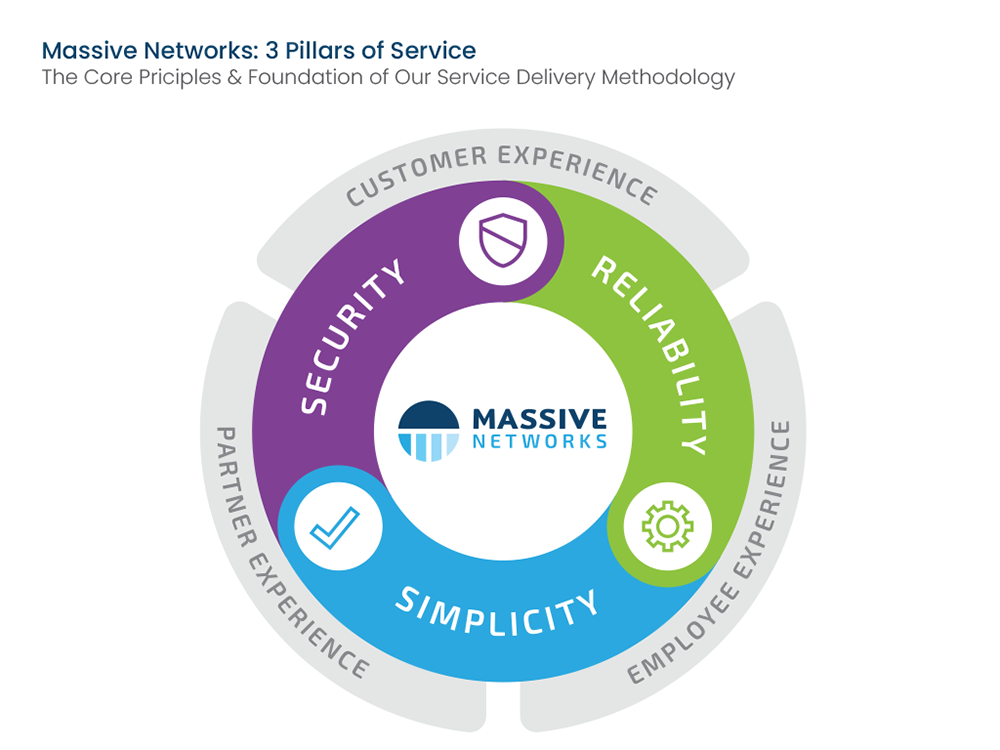The Art of Carrier Consolidation
Streamlining Network Management by Eliminating Vendor Sprawl
Managing multiple network providers has long been a necessary compromise for businesses seeking to balance performance, redundancy, and geographic reach. Yet, for all its intended benefits, the multi-provider model often leads to overwhelming complexity, inefficiencies, and unforeseen challenges. From navigating diverse billing systems to coordinating across inconsistent support structures, managing multiple carriers diverts valuable time and resources away from strategic goals.
Carrier consolidation offers a transformative alternative. By uniting all connectivity solutions under a single provider, businesses can eliminate the headaches of vendor sprawl and unlock new levels of operational efficiency. Consolidation simplifies everything from provisioning and support to security and performance management, allowing teams to focus on growth rather than troubleshooting. It’s not just about reducing complexity; it’s about creating a foundation for long-term success.

This guide explores the challenges of managing multiple network providers, the strategic benefits of carrier consolidation, and why partnering with the right provider can redefine how your business operates. Whether you’re seeking enhanced reliability, streamlined management, or a more secure network infrastructure, the shift to carrier consolidation is more than a technical change—it’s a strategic necessity.
Why Businesses Rely on Multiple Network Providers
For many organizations, relying on multiple network providers has been a necessary evil. Businesses want to ensure they have the global reach necessary to stay competitive, the redundancy required to maintain seamless operations, and the flexibility to align their connectivity with strategic goals. Let’s dig into why organizations striving for excellence choose this approach:
- Geographic Reach and Redundancy: Distributed locations often necessitate multiple providers to ensure coverage across broad geographic areas. Understandably, no single ISP has complete reach, and the risk of a single point of failure can be terrifying. Imagine losing connectivity in a critical region simply because your sole provider experienced an outage. By relying on multiple carriers, businesses try to safeguard against these risks. However, while this approach seems logical, it often comes with unforeseen complications.
- Performance Needs and Optimization: Some applications need near-perfect conditions to function properly. You might route VoIP traffic through a premium, low-latency ISP while using a budget provider for less critical operations. On paper, it makes sense. In practice, juggling these connections can feel like a full-time job. The effort to optimize every aspect of your network can pull IT teams away from strategic initiatives, and even then, results are often mixed.
- Remote and Difficult-to-Serve Locations: We’ve all faced the challenges of connecting out-of-the-way locations, either a remote office or a facility in an area with minimal infrastructure. Often, businesses have no choice but to mix and match providers, dealing with inconsistent performance and unexpected limitations. Regulatory hurdles and geographical challenges can make this even harder, leaving businesses feeling stuck with solutions that barely meet their needs.

Downside of Managing Multiple Network Providers
While multiple ISPs can address certain issues, they introduce a host of operational challenges that impact efficiency and performance, including:
- Increased Complexity: For teams responsible for ordering and managing network solutions, overseeing multiple providers is an ongoing struggle. Coordinating orders, resolving disputes, and aligning timelines across vendors quickly becomes overwhelming. Each provider operates with its own systems, processes, and points of contact, leading to miscommunication and delays. Employees often spend countless hours tracking down the right contacts, pushing for accountability from providers who don’t know their company’s needs or feel any urgency to resolve issues.
- Billing and Invoicing Challenges: If you’ve ever dealt with billing across multiple ISPs, you know how frustrating it can be. Different formats, cycles, and pricing structures can lead to delayed payments and reconciliation nightmares. For businesses aiming to simplify operations, this level of administrative burden can be overwhelming, and it’s often entirely avoidable.
- Support and Downtime Frustrations: When something goes wrong, the finger-pointing between providers can turn a minor issue into a major disruption. Navigating a maze of support channels, each with its own response times and accountability standards can significantly delay resolution. Without an integrated system to manage failovers, these delays often lead to extended downtimes that impact productivity and business continuity. This lack of coordinated support creates stress and frustration across your organization, leaving teams reactive rather than proactive.
- Security and Visibility Risks: A fragmented network with multiple providers can feel like a patchwork, barely holding together. Gaps in security protocols and a lack of centralized visibility leave businesses vulnerable to both external threats and operational inefficiencies. Without a unified view of network performance and security, identifying and resolving issues becomes a reactive process, increasing risks to sensitive data, operational stability, and overall productivity.
Consider This:
(Source: Ponemon Institute, 2022 Data Risk in the Third-Party Ecosystem)
63% of organizations cite a lack of centralized control over third-party relationships, while 53% identify the complexity of these relationships as major barriers to maintaining a comprehensive vendor inventory. Without visibility into their various vendor ecosystems, businesses face heightened risks and inefficiencies.
These challenges illustrate why businesses are rethinking the multi-provider model. Transitioning to carrier consolidation doesn’t just eliminate these inefficiencies—it frees teams to focus on growth and innovation rather than getting bogged down in operational hurdles.
The Solution: Carrier Consolidation
Carrier consolidation simplifies network management by integrating multiple carrier services under a single provider. This approach directly addresses the challenges of multi-provider setups while retaining the benefits of redundancy and performance optimization:

- Simplified Management: Consolidating providers eliminates the complexity of juggling multiple systems and processes. With a single provider, you gain a dedicated point of contact who knows your name and understands your business needs. This partner takes on the complexities of navigating provider portals and phone trees, freeing your team from the frustration of chasing down multiple contacts or pushing carriers to fulfill their obligations. Instead, your teams can focus on their jobs, while your dedicated contact ensures smooth operations.
- Unified Billing and Invoicing: By managing all connectivity solutions through one provider, businesses eliminate the headaches of varying billing cycles and payment formats. A single, unified invoice streamlines reconciliation processes and reduces administrative burdens, making it easier for finance teams to maintain focus on higher-value tasks.
- Improved Support and Uptime: With a single point of contact, businesses can resolve issues faster and more effectively. Centralized support ensures accountability and proactive management, minimizing downtime and ensuring smooth failover processes during disruptions. Teams gain peace of mind knowing they have one reliable partner to turn to in critical moments.
- Enhanced Security and Visibility: Carrier consolidation offers a unified view of network performance and security, making it easier to identify vulnerabilities and resolve issues. Consistent security protocols reduce risks, while centralized visibility empowers teams with actionable insights to optimize operations, ensuring alignment with organizational goals.
- Cost and Resource Efficiency: Managing fewer providers reduces hidden costs and operational inefficiencies. Carrier consolidation frees up internal resources, enabling businesses to invest time and energy into strategic initiatives rather than day-to-day management. This streamlined approach maximizes ROI by focusing efforts on core business objectives.
These benefits illustrate how carrier consolidation not only addresses the downsides of managing multiple providers but also provides a foundation for a more resilient, secure, and efficient network infrastructure.
Integrated Redundancy Through Carrier Consolidation
Internet redundancy isn’t just a safety net—it’s a critical business necessity. Whether it’s a fiber cut, hardware failure, or natural disaster, a well-designed redundancy strategy ensures operations remain uninterrupted.

With carrier consolidation, redundancy becomes a seamless and integrated part of your network strategy. A single provider can streamline both physical and logical safeguards, eliminating the complexity of managing multiple systems:
- Physical Redundancy Simplified: Dual fiber paths, multiple last-mile connections, and diverse routes are managed cohesively by a consolidated partner, ensuring seamless failovers without the need for juggling multiple providers.
- Logical Redundancy Made Smarter: Configurations like automatic failovers to multiple Tier 1 ISPs and dynamic routing are optimized through a single provider who understands your network’s unique requirements. This ensures critical systems stay online with minimal disruption.
- High-Performance Grade Solutions: A consolidated partner can balance redundancy needs across varying performance levels, from cost-effective options for basic connectivity to high-speed failover strategies for mission-critical applications. By blending Tier 1 ISPs, your network achieves optimal resiliency without sacrificing efficiency.
By integrating these safeguards into a unified system, carrier consolidation ensures that your redundancy strategy is not just practical but also easy to manage. Unified management across multiple connections allows businesses to focus on growth instead of preparing for the worst.
Choosing the Right Partner for Carrier Consolidation
Selecting the right partner is essential to unlocking the full potential of carrier consolidation. The right provider doesn’t just offer services—they become an extension of your team, ensuring seamless operations and alignment with your business goals. Here’s what to look for:

Multi-Carrier Access: Your provider should have access to multiple Tier 1 carriers, enabling them to deliver unmatched connectivity options while managing these relationships on your behalf. This ensures a single carrier’s limitations don’t constrain your business.

Ironclad SLAs: Service Level Agreements (SLAs) should include clear performance guarantees and defined recourse for disruptions. These agreements ensure accountability and provide peace of mind that your operations will remain uninterrupted.

Strong Support Infrastructure: A dependable partner will offer proactive monitoring, fast response times, and consistent communication. This infrastructure minimizes downtime and ensures your network runs smoothly, freeing your teams from the burden of managing support tickets.

Tailored Solutions: Look for a provider who understands your specific business needs and can design solutions that fit your operational goals. From redundancy strategies to security protocols, their offerings should be as unique as your business.

With the right partner, carrier consolidation doesn’t just streamline operations—it transforms your network into a strategic advantage.
The Massive Networks Advantage
Carrier consolidation is the bridge between the challenges of managing multiple providers and the opportunity to simplify operations, improve efficiency, and secure a more resilient network. Massive Networks provides the expertise and infrastructure to make this transition seamless. By managing connections across multiple Tier 1 carriers, we ensure businesses can consolidate their connectivity needs without sacrificing reliability or performance.
- Reliability: Massive Networks ensures that each of our products and services are engineered for consistent and robust performance. By integrating high-availability features and multiple redundancies, we deliver a dependable infrastructure that supports seamless operations and minimizes the risk of service interruptions.
- Security: Every solution is meticulously designed with security at its core. We employ strict data protection protocols and secure data segmentation across our services, safeguarding critical data assets from unauthorized access and ensuring compliance with industry standards.
- Simplicity: Massive Networks transforms complex multi-vendor networks into streamlined, unified solutions. Our single-provider model reduces operational complexity, centralizing management, billing, and support under one trusted partner. This approach simplifies processes for enterprise clients while enhancing overall service quality.

Choosing Massive Networks as your consolidation partner means gaining a team committed to delivering unmatched reliability, security, and simplicity. Let us help your business navigate the complexities of network management and turn connectivity into a competitive advantage.








